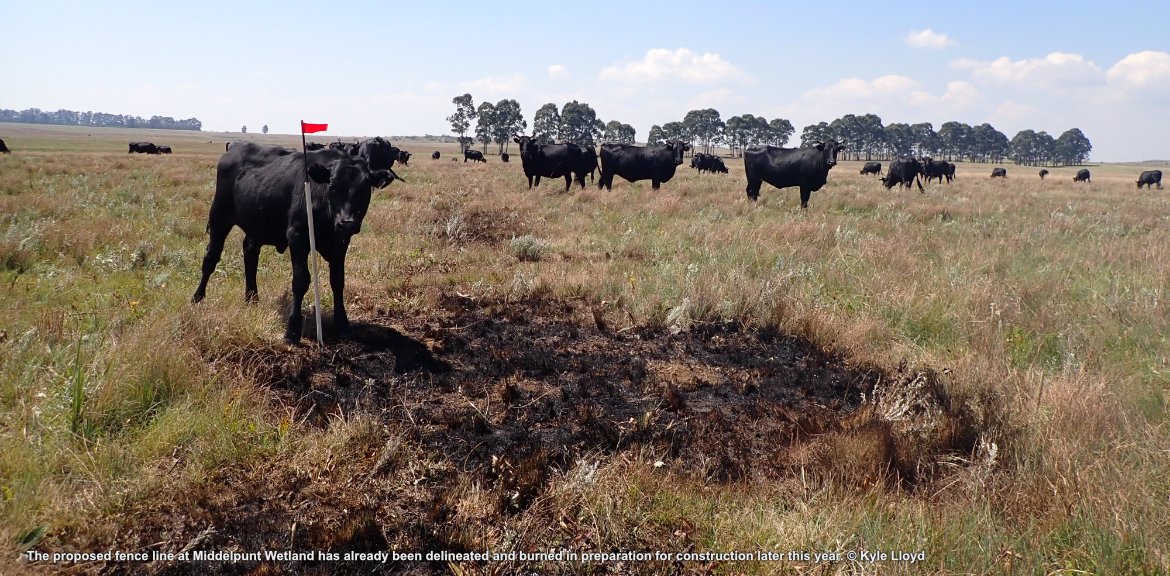
Purchase 10 m of fence for just R500 to help us reach our target of 4 km of wildlife-friendly fence that will protect sensitive wetland vegetation from being trampled and overgrazed by cattle.

The White-winged Flufftail is listed as Critically Endangered, with an estimated global population size of fewer than 250 mature individuals. It is considered to be the rarest and most threatened rallid species in Africa. Ethiopia and, more recently, South Africa are the only two countries where the White-winged Flufftail is known to breed, with only one confirmed site in South Africa: Middelpunt Wetland. The White-winged Flufftail was first seen at Middelpunt Wetland in 1992 after many years with no presence records in the country. Those who saw the bird were concerned about the condition of the wetland and engaged with the owner to rehabilitate it. A lease was eventually signed in 1994 and Middelpunt Wetland Trust was formed as the vehicle through which to operate. BirdLife South Africa was invited to administer Middelpunt Wetland Trust in 2011 and has since then led national efforts to conserve this highly threatened species. Middelpunt Wetland formed part of the Greater Lakenvlei Protected Environment when it was established in 2017. Whilst this form of protection limits activities that could threaten biodiversity, it does not prevent them entirely.
Inland wetlands across South Africa are mismanaged due to a lack of understanding of the drivers that govern wetland structure and functionality. Often livestock are left to graze in wetlands at the wrong time of year, resulting in sensitive wetland vegetation being trampled and overgrazed when wildlife need these habitats to breed and rear young. In agricultural landscapes, controlling the movement of livestock (and thus the main form of grazing) is essential for properly managing and stewarding wetlands. Standard cattle fencing provides a means to control livestock movements, but often at the cost of inhibiting, or seriously injuring, native wildlife. Thus, an innovative design is needed to effectively control livestock movements, whilst also allowing wildlife to freely move through the landscape.
The wildlife-friendly fence proposed for Middelpunt Wetland will not only benefit the site itself, but will be evaluated and communicated in national wetland management guidelines for implementation across southern Africa.

Dr Kyle Lloyd
Rockjumper Fellow of White-winged Flufftail Conservation
BirdLife South Africa
Please consider supporting our quest to conserve the White-winged Flufftail and wetlands for the benefit of people and biodiversity by making a donation via Quicket.

The Rockjumper Fellow of White-winged Flufftail Conservation
Kyle Lloyd grew up in the Western Cape and KwaZulu-Natal provinces of South Africa, where he developed a passion and love for nature. He studied for his BSc and BSc Honours at Rhodes University where like-minded people soon had him bitten by the birding tick. During the course of his studies, Kyle developed a concern for humanity’s abuse of natural resources and the lack of communication between scientists and practitioners. Kyle pursued his MSc in Conservation Biology at the FitzPatrick Institute of African Ornithology at the University of Cape Town where he was equipped with the tools needed to address environmental concerns. In desperate need of a break from studying, Kyle then grasped the opportunity to spend 13 months at Marion Island, where he collected data about elephant seals, fur seals and killer whales in a sub-Antarctic wilderness. He then completed his PhD on the Population and individual life history consequences of polygyny in male southern elephant seals at the University of Pretoria before starting his career at BirdLife South Africa. ‘I see this position as the perfect marriage of research and public engagement that uses evidence-based strategies to inform management decisions. I feel truly honoured to be a part of this endeavour and am grateful for the support of Rockjumper Birding Tours.’
